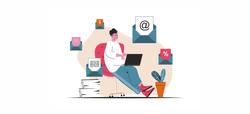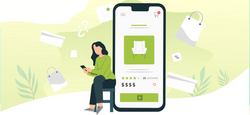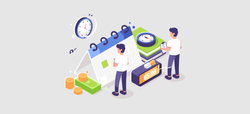Email marketing is an incredibly useful tool for any business, and when done right, can achieve remarkable results for customer loyalty, return on investment and brand reputation.
There are so many benefits to using this channel for marketing. Statistics show that 99% of consumers check their emails every day, enabling this to be one of the most effective methods of communication. Also being able to personalise and tailor content specifically and directly to the consumer means that email marketing converts better than other communication avenues like social media.
A more targeted marketing approach is additionally possible by creating an email list and database of customers, allowing a better understanding of the consumer demographic, which ultimately leads to achieving a higher return on investment.
When establishing the strategy, it is important to consider the marketing sequence in order to have the correct approach for the customer at each phase. This can be broken down into three stages; prospective customers, active consumers, and subscribed customers.
Prospective customers
The email approach at this stage should be aimed at drawing in prospective customers, enticing them enough to encourage them to purchase, subscribe, and become active consumers.
A lead magnet is a good way to draw them in. People are not always willing to give out their email address freely as it is quite personal, so incentives can help. The magnet can be anything such as a free giveaway, a chance to win something or receive a one-time offer or promotion. As long as it is something that offers immediate gratification and is relevant and easily consumed, it will surely encourage prospective customers to share their email address with you.
Once the new customer is signed up, you can begin the welcome series. First impressions are everything, so it is good to start with a warm welcome email, thanking the customer for their purchase/subscription, followed by an introduction to the company and what you can offer the customer. This is the time to let the customer know what they can expect from you, such as regularity of emails, any upcoming promotions, or other benefits and features offered exclusively to subscribers.
Here is an example of a welcome email by Birchbox that is personal, easily digestable and informative:

Active consumers
Once the new customers are nicely settled in and have an understanding of the company, it is a good opportunity to try and make a sale. Customers are most interested in you when they first sign up, and therefore much more likely to respond to what you are offering, even more so if there is a sense of urgency by means of a short-term promotion. This is a good time to show the customer that you can deliver everything you said you would in the first few welcome emails, consolidating the confidence and loyalty of the customer.
Establishing a more personal connection with the consumer additionally retains interest and trust, nurturing a positive relationship between brand and consumer. This can be easily done with simple gestures such as sending thank you emails after a customer has made a purchase, or congratulatory offers on their birthday.
As your database of emails starts to grow, it can be useful to create an email list segmentation, assembling smaller groups defined by specific criteria. This way, you are able to send out emails that are more relevant and geared towards each group, rather than sending something generic to everyone, thereby achieving a more targeted approach.
For example, two groups could be categorised by consumers who make regular purchases and consumers who frequently abandon cart without making a purchase. The regular purchase group can be sent review requests and loyalty program offers, rewarding the customers and encouraging further engagement with the brand. Cart abandonment emails can be sent to the other group, with a gentle nudge to remind them to continue and make the purchase.
Here is an example of an email from Sattva with a membership offer that includes a discount incentive, a sense of urgency as well as details of all the benefits of purchasing the membership:

And here is an example of a cart abandonment email from CaliFabrics, not only with a reminder of the abandoned basket, but also 5-star reviews of the item from other customers and a time-sensitive discount for added incentive:

Subscribed customers
A good way of keeping customers coming back to you is by pre-empting the customer’s needs and sending replenishment emails at the right time. For example, if the customer has bought a product in the past that is due to run out, a well-timed email reminding them to re-stock will be what brings them back to you to buy again. This can also be an opportunity to upsell and offer something else relevant that could also be of interest to the consumer.
Inactive subscribers is an inevitability, therefore re-engagement emails are another way to draw the consumer back in, rekindle the relationship and encourage them to buy again. An offer or promotion could be a good incentive, even better when timed with a holiday or occasion, and with direct and personal messaging.
Here is a simple but effective example from Grammerly, with subtle flattery enough to motivate the customer to click on the pronounced call-to-action button:

General
In addition to this effective email sequence, there are a few other vital factors to consider throughout the marketing journey to ensure the best results.
Firstly, it is imperative to make sure the subject line is enticing so the consumer is curious enough to open the emails in the first place. In the same vein, the content of the email should always be visually appealing with well-written copy to make sure that it is consistently engaging and keeps the consumer interested.
Statistics show that around 50% of consumers and 35% of business professionals check their emails on their mobile phones daily, a number that is only increasing. Therefore, it is important to ensure the design of the email is responsive and optimised for mobile phones. This includes factors like simple formatting and a single column of text. Smaller image files mean less load time, and a large call-to-action button is seen and accessed better.
Here is an example from 99Designs that displays clear formatting and is easy to read on a smaller screen:

It is useful to keep an eye on open, click-through and unsubscribe rates throughout the email journey. This can be an indicator of which area of your email strategy is not strong enough.
If the open rate is low, it is likely that the subject line is not captivating enough. If the click-through rate is low, it could be because the copy is not up to scratch, or perhaps the call-to-action is unclear. Finally if the unsubscribe rate is high, you must consider if you are sending too many sales emails, or whether the emails are irrelevant or uninteresting to the consumer.
This behaviour might also be affected by when the email is being received. A/B tests can be performed to perfect the timing and ascertain which days and times have the highest open and click-through rates. It is also possible to check other reports that have already been done by other similar businesses and shared online.
Finally there must be a balance between value and sales emails, otherwise your emails will quickly drop into the spam folder if they are too repetitive and salesy.
Tips
To run successful email marketing campaigns, you can use Jumpseller’s built-in Marketing Automation tools! We recommend the following apps for this purpose:
-
E-goi : A marketing automation platform complete with several features, including email marketing, SMS marketing, Web Push and Push Notifications.
-
MailChimp : MailChimp is the world’s largest marketing automation platform, known mostly for its email marketing features worldwide.
Sources:
https://blog.hubspot.com/marketing/email-marketing-stats https://optinmonster.com/beginners-guide-to-email-marketing/ https://www.activecampaign.com/blog/welcome-email-series





